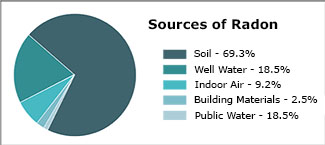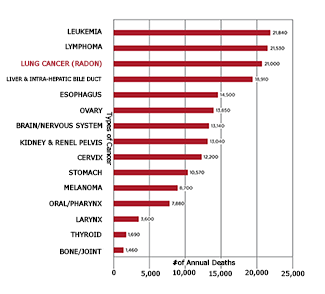Deadly Home Invasion: Radon
The Dangers of Radon
One in fifteen homes in the United States has a silent killer lurking in the shadows. It is there when the Homeowners return from work, cook dinner and while spending time with loved ones. This silent killer is invisible, odorless, tasteless – and completely preventable - yet it kills more than 20,000 Americans a year.
Fact: Radon is the leading cause of cancer among nonsmokers in the U.S., killing over 20,000 Americans annually.

The U.S. Surgeon General has warned that radon is the second leading cause of lung cancer in the United States today. Only smoking causes more lung cancer deaths. If you smoke and your home has high radon levels, your risk of lung cancer is especially high.
Radon comes from the natural (radioactive) breakdown of uranium in soil, rock, and water and gets into the air you breathe. Radon can be found all over the U.S. It can get into any type of building - homes, offices, and schools - and result in a high indoor radon level.
Radon can enter a home through cracks in the foundation floor and walls, through basement floor drains, and through sump openings. Homes with dirt crawl spaces have increased radon exposure levels. However, even houses with a seemingly tight concrete foundation can have high radon levels.
We cannot smell, taste, see, touch, or hear radon. Thus, it easily goes unnoticed. When this happens, everyone in the home becomes susceptible to contracting lung cancer. There are also very limited lung cancer symptoms.
Symptoms may include:
- Persistent cough
- Hoarseness
- Wheezing
- Shortness of breath
- Coughing up blood
- Chest pain
- Frequent infections like bronchitis and pneumonia
- Loss of appetite
- Weight loss
- Fatigue
Don't Wait, Test & Mitigate!
Radon is measured in picocuries per liter (pCi/L). A picocurie is one-trillionth of a curie (which is the amount of radioactivity emitted by one gram of radium.
The Environmental Protection Agency has established mitigation guidelines that recommend mitigation at levels above 4 pCi/L while the World Health Organization has established remediation guidelines at 2 pCi/L.
Fortunately, Arizona Foundation Solutions is Arizona's radon mitigation expert. We have affordable testing and mitigation options available for homes in all sizes. Visit www.FoundationRepairWithRosie.com to learn more and schedule your radon mitigation appointment!
 Fact: The U.S. Surgeon General has recommended that every home in the United States be tested for radon.
Fact: The U.S. Surgeon General has recommended that every home in the United States be tested for radon.
Radon FAQs
Q: Is radon REALLY a problem?
A: Yes. The Center for Disease Control, the American Lung Association & the Environmental Protection Agency all agree that radon causes thousands of preventable lung cancer deaths each year.
Q: My house is new/old. Do I really need to test?
A: Yes. Old or new, the house itself may be trapping radon gas within its walls & exposing those residing inside to health hazards.
Q: I do not have a basement or crawlspace, do I need to be concerned about radon?
A: Yes; while home design (basement, crawl spaces, etc.) can have an impact on radon levels, radon has been found in homes of all types.
Q: At what level should we remediate?
A: The Environmental Protection Agency has established mitigation guidelines that recommend mitigation at levels above 4 pCi/L.
Q: Are radon mitigation systems expensive?
A: A radon mitigation system is affordable & we have a financing option for those who qualify.
Fact: Radon levels of 4 pCi/L is equal to smoking 8 cigarettes a day.
Home Maintenance To-Do | #Radon
Sponsored by: Arizona Foundation Solutions
 Arizona Foundation Solutions serves Arizona by providing long-term solutions for structures with foundation problems. No two structures are alike, which is they take the time to thoroughly assess your problem to determine the best solution for your foundation or concrete slab. They are the only "Certified Foundation Repair Specialist" from the National Foundation Repair Association in the State of Arizona, and the only foundation repair company in Arizona with a licensed civil engineer on staff.
Arizona Foundation Solutions serves Arizona by providing long-term solutions for structures with foundation problems. No two structures are alike, which is they take the time to thoroughly assess your problem to determine the best solution for your foundation or concrete slab. They are the only "Certified Foundation Repair Specialist" from the National Foundation Repair Association in the State of Arizona, and the only foundation repair company in Arizona with a licensed civil engineer on staff.
###
Photo Credits:
